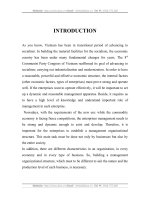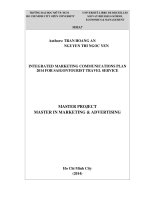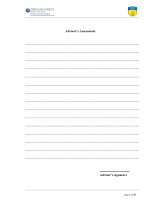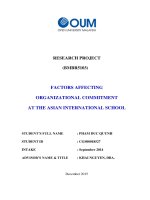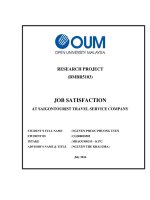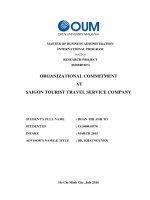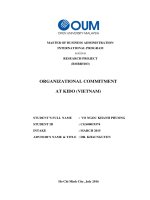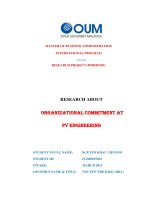Organizational commitment at saigontourist travel service company
Bạn đang xem bản rút gọn của tài liệu. Xem và tải ngay bản đầy đủ của tài liệu tại đây (1.21 MB, 68 trang )
MASTER OF BUSINESS ADMINISTRATION
INTERNATIONAL PROGRAM
RESEARCH PROJECT
(BMBR5103)
ORGANIZATIONAL COMMITMENT
AT
SAIGON TOURIST TRAVEL SERVICE COMPANY
STUDENT’S FULL NAME
: DOAN THI ANH TO
STUDENT ID
: CGS00019370
INTAKE
: MARCH 2015
ADVISOR’S NAME & TITLE
: DR. KHAI NGUYEN
Ho Chi Minh City, July 2016
ACKNOWLEDGEMENTS
Dear Dr. Khai,
I am great grateful for the valid helps from my supervisor who offers many
valid comments about this dissertation.
I am grateful for employees of SaigonTourist Travel Service Company in
Vietnam who offer valid information for me to complete this dissertation.
I am also grateful for my family members, colleagues, and friends who
always give me a motive to complete this dissertation.
Student - Doan Thi Anh To
CONTENTS
ABSTRACT ................................................................................................................... 1
CHAPTER ONE: INTRODUCTION.......................................................................... 2
1.1 Introduction of Saigontourist Travel Service Company in Vietnam ......................... 2
1.2 Problem statement ..................................................................................................... 6
1.3 Research objectives ................................................................................................... 7
1.4 Research scope .......................................................................................................... 8
1.5 Research questions .................................................................................................... 8
1.6 Significance of research ............................................................................................ 9
CHAPTER TWO: LITERATURE REVIEW .......................................................... 10
2.1 Definition of constructs ........................................................................................... 10
2.1.1 Organizational commitment ................................................................................. 10
2.1.2 Job cognition ........................................................................................................ 12
2.1.3 Work-related expectancies ................................................................................... 12
2.1.4 Empowerment at work scale ................................................................................ 13
2.1.5 Goal and process clarity ....................................................................................... 13
2.1.6 Perceived person-organization fit ......................................................................... 14
2.2 Arguments for the relation amongst the constructs ................................................. 15
2.2.1 The relation amongst job cognition and organizational commitment .................. 15
2.2.2 The relation amongst work-related expectancies and organizational commitment15
2.2.3 The relation amongst empowerment at work scale and organizational
commitment ................................................................................................................... 16
2.2.4 The relation amongst goal and process clarity and organizational commitment . 16
2.2.5 The relation amongst perceived person-organization fit and organizational
commitment ................................................................................................................... 17
2.3 Hypotheses............................................................................................................... 18
2.4 Research model........................................................................................................ 19
CHAPTER THREE: METHODS ............................................................................. 20
3.1 Data collection ......................................................................................................... 20
3.1.1 Designing template scale ...................................................................................... 20
3.1.1.1 Organizational commitment .............................................................................. 20
3.1.1.2 Job cognition ..................................................................................................... 21
3.1.1.3 Work-related expectancies ................................................................................ 22
3.1.1.4 Empowerment at work scale ............................................................................. 23
3.1.1.5 Goal and process clarity .................................................................................... 23
3.1.1.6 Perceived person-organization fit ...................................................................... 25
3.1.2 Progress of data collection.................................................................................... 25
3.2 Data analysis ............................................................................................................ 26
CHAPTER FOUR: RESULTS ................................................................................... 28
4.1 Demographic information ....................................................................................... 28
4.2 Reliability test .......................................................................................................... 29
4.2.1 Conditions of reliability test ................................................................................. 29
4.2.2 Cronbach’s Alpha of constructs ........................................................................... 30
4.2.2.1 Organizational commitment (OC – Main construct) ......................................... 30
4.2.2.2 Job cognition ..................................................................................................... 30
4.2.2.3 Work-related expectancies ................................................................................ 31
4.2.2.4 Empowerment at work scale ............................................................................. 31
4.2.2.5 Goal and process clarity .................................................................................... 31
4.2.2.6 Perceived person-organization fit ...................................................................... 32
4.3 Statistics information ............................................................................................... 32
4.3.1 Descriptive statistics ............................................................................................. 32
4.3.2 Correlation analysis .............................................................................................. 33
4.4 Hypothesis testing ................................................................................................... 35
4.4.1 Testing of hypothesis 1 ......................................................................................... 35
4.4.2 Testing of hypothesis 2 ......................................................................................... 36
4.4.3 Testing of hypothesis 3 ......................................................................................... 37
4.4.4 Testing of hypothesis 4 ......................................................................................... 38
4.4.5 Testing of hypothesis 5 ......................................................................................... 39
CHAPTER FIVE: CONCLUSIONS ........................................................................ 42
5.1 Discussion ................................................................................................................ 42
5.2 Study conclusions .................................................................................................... 43
5.3 Study limitations ...................................................................................................... 44
5.4 Recommendations ................................................................................................... 46
REFERENCES ............................................................................................................ 48
APPENDIX 1: QUESTIONNAIRE ........................................................................... 54
APPENDIX 2: PRESENTATION.............................................................................. 59
TABLE
Table 1: Organizational commitment ............................................................................ 20
Table 2: Job cognition ................................................................................................... 21
Table 3: Work-related expectancies .............................................................................. 22
Table 4: Empowerment at work scale ........................................................................... 23
Table 5: Goal and process clarity .................................................................................. 24
Table 6: Perceived person-organization fit.................................................................... 25
Table 7: Timetable for the progress of data collection .................................................. 26
Table 8: Demographic information of surveyed employees ......................................... 28
Table 9: Conditions of examining the reliability of items ............................................. 29
Table 10: Cronbach’s Alpha of Organizational commitment ....................................... 30
Table 11: Cronbach’s Alpha of Job cognition ............................................................... 30
Table 12: Cronbach’s Alpha of Work-related expectancies ......................................... 31
Table 13: Cronbach’s Alpha of Empowerment at work scale....................................... 31
Table 14: Cronbach’s Alpha of Goal and process clarity ............................................. 31
Table 15: Cronbach’s Alpha of Perceived person-organization fit ............................... 32
Table 16: Descriptive statistics of variables .................................................................. 33
Table 17: Correlation analysis of variables ................................................................... 34
Table 18: Model Summary of Hypothesis 1 ................................................................. 35
Table 19: Coefficients of Hypothesis 1 ......................................................................... 36
Table 20: Model Summary of Hypothesis 2 ................................................................. 36
Table 21: Coefficients of Hypothesis 2 ......................................................................... 37
Table 22: Model Summary of Hypothesis 3 ................................................................. 37
Table 23: Coefficients of Hypothesis 3 ......................................................................... 38
Table 24: Model Summary of Hypothesis 4 ................................................................. 38
Table 25: Coefficients of Hypothesis 4 ......................................................................... 39
Table 26: Model Summary of Hypothesis 5 ................................................................. 39
Table 27: Coefficients of Hypothesis 5 ......................................................................... 40
Business Research Methods
P a g e 1 /62
ABSTRACT
The aim of this study is to analyze factors affecting organizational commitment of employees
of STSC in Vietnam. With the research aim, this research has three main objectives as
follows: (1) to research the main theories related to organizational commitment of employees,
(2) to analyze whether factors like job cognition, empowerment at work scale, goal and
process clarity, perceived person-organization fit and work-related expectancies will have
effects on organizational commitment of employees of STSC in Vietnam and (3) to suggest
recommendations for managers of STSC in Vietnam to increase its employees’ organizational
commitment in the future. This research is performed by the quantitative study method and
the offline surveys of 500 employees of STSC in Vietnam. The valid information of 270
questionnaires is used to gain the study objectives. This research used the SPSS software of
version 16 to analyze the collected data. Hypotheses used in this study consist of six
constructs: A dependent construct (organizational commitment) and five independent
constructs (job cognition, empowerment at work scale, goal and process clarity, perceived
person-organization fit and work-related expectancies). After examining all the five
hypotheses through correlation analysis and regression analysis, this research concludes that
H1, H2, H3, and H4 are supported while H5 is not supported. In other words, job cognition,
empowerment at work scale, goal and process clarity, and work-related expectancies have
positive effects on organizational commitment of employees in STSC in Vietnam while
perceived person-organization fit does not have any effect on organizational commitment of
employees in STSC in Vietnam.
Key words: Job cognition, empowerment at work scale, goal and process clarity, perceived
person-organization fit, work-related expectancies and organizational commitment
Student: Doan Thi Anh To (ID19370)
Business Research Methods
P a g e 2 /62
CHAPTER ONE: INTRODUCTION
1.1 Introduction of Saigontourist Travel Service Company in Vietnam
Core business
Saigontourist Travel Service Company (STSC) in Vietnam is a tourism company that has the
headquarters in Vietnam. Tourism services of this company include business travel service,
travel services combined with conference, meeting, workshop, social program, and event,
cruise travel, etc. The tourism services of this company have satisfied many customers in
Vietnam and international customers. This company was established in 1975. This company
has had strong relationships with more than 400 tourism companies, and agents from many
nations such as Japan, France, Spain, the United States, Germany, China, South of Korea, the
United Kingdom, etc. and is official member of international tourism associations (JATA,
PATA, USTOA and ASTA), Ho Chi Minh City Travel Association and Vietnam Tourism
Association (Saigontourist Travel Service Company, 2016a).
According to Saigontourist Travel Service Company (2016b), STSC in Vietnam concentrates
on various business activities to serve all needs and expectations of its customers and core
business activities of this company are as follows:
-
Inbound travel: Tourism services serve international customers to visit regions, cities
and communities of Vietnam.
-
Outbound travel: Tourism services serve international customers and domestic
customers to visit regions, cities and communities of nations outside Vietnam like
Hong Kong, China, France, Italia, Canada, Belgium, Japan, Australia, Germany, the
United States, New Zealand, South Korea, Spain, etc.
Student: Doan Thi Anh To (ID19370)
Business Research Methods
-
P a g e 3 /62
Domestic travel: Tourism services serve domestic customers to visit regions, cities and
communities of Vietnam.
Development timeline
According to Saigontourist Travel Service Company (2016a), there are three main business
development period of STSC in Vietnam as follows:
From 1975 to 2000
STSC in Vietnam gained many rewards from the Vietnamese government from 1975 to 2000.
In 2000, this company was the first tourism company serving more than 100,000 inbound
cruise tourists to Vietnam. Its customers considered this company as the place for them to
gain excellent tourism services.
From 2001 to 2010
STSC in Vietnam gained the brand reputation through applying the tourism service
differentiation strategy from 2001 to 2010. In 2010, this company had more than 50,000
cruise travelers participating trans-Viet tours and received many awards from the Vietnamese
government such as High Quality Tourism Service and Innovation Tourism Service.
From 2011 to now
STSC in Vietnam has opened new offices in many cities to serve many customers in domestic
market and international markets from 2011 to now. This company has received many awards
from the Vietnamese government such as Vietnam Golden Star Award and High Quality
Tourism Service.
Student: Doan Thi Anh To (ID19370)
Business Research Methods
P a g e 4 /62
Organizational structure
Source: Adapted from Saigontourist Travel Service Company (2016a)
STSC’s vision
According to Saigontourist Travel Service Company (2016a), the vision of STSC in Vietnam
is to become one of the leading tourism companies in the Vietnamese tourism industry in
terms of sustainable business development level, and high profits. In order to achieve this
vision, this company focuses much on five competitive advantages, that is, (1) technological
innovation, (2) positive organizational culture and governance system, (3) communityoriented brand, (4) innovative tourism services and (5) strongly integrated value chain.
Technological innovation: STSC in Vietnam is willing to buying modern equipment
and using advanced tourism technologies to create convenience for its customers and
to increase satisfaction level of its customers. Indeed, this company is one of the
tourism companies in Vietnam of pioneering application of innovative tourism
Student: Doan Thi Anh To (ID19370)
Business Research Methods
P a g e 5 /62
technologies. Due to advanced tourism technologies, this company’s tourism services
always have the high quality and satisfy standards of international tourism quality
Positive organizational culture and governance system: STSC in Vietnam has created
the governance system that focuses much on financial reporting transparency and clear
information communication. The corporate culture of this company is to focus much
on encouraging innovation of employees, offering rewards for employees who have
innovation ideas in developing tourism services, ensuring organizational justice, and
welcoming organizational changes.
Community-oriented brand: STSC in Vietnam has high supports for activities of
communities where it is operating. This company expects that it can share its wealth
with its communities and always offers the highest values for its customers and its
stakeholders. In particular, in 2015, this company participated in charity activities of
communities in Vietnam so that it can improve living standards of poor people in
Vietnam and encouraged its employees to participate voluntarily in social activities of
communities in Vietnam to enhance the growth of the whole society of Vietnam.
Innovative tourism services: STSC in Vietnam considers innovation in tourism
services as the way to increase the competition position in the Vietnamese tourism
industry and then, this company focuses much on research and development (R&D)
activities to create a range of innovative tourism services. This company has had a
range of innovative tourism services that meet needs and expectations of its customers
and this is the way for this company to retain its current customers and to attract
attention of its potential customers.
Strongly integrated value chain: STSC in Vietnam focuses much both primary
activities and support activities so that this company creates a strong integrated value
chain. Indeed, all its organizational members have strongly mutual supports to gain the
Student: Doan Thi Anh To (ID19370)
Business Research Methods
P a g e 6 /62
common organizational goals. Through the integrated value chain, the high-quality
tourism services of this company are offered to its customers. With strongly integrated
value chain, STSC in Vietnam ensures the innovation in controlling expenses during
the process of offering tourism services to gain the cost effectiveness. Currently,
STSC in Vietnam is conducting the cost-leadership strategy as its competition
strategy.
STSC’s mission
According to Saigontourist Travel Service Company (2016a), the mission of STSC in
Vietnam is to offer tourism services with the international quality level, and suitable price
levels to its customers to satisfy needs and expectations of its customers, to contribute the
growth of economy, society, and communities of Vietnam, to offer fair treatment to its
employees, and to balance benefits of all its stakeholders.
1.2 Problem statement
In terms of human resource management (HRM), it is an important function in companies that
is planned to increase work efficacy of employees (Arustei, 2013). HRM is about
management of members in companies, concentrating on systems and policies (Bhatnagar,
2007) by conducting a range of activities like staff recruitment, work efficacy evaluation,
training program, rewards, etc. (Borghei et al., 2010). In the recent global context, the
majority of companies conduct their HRM practices through retaining and developing the
capabilities of their employees. This means that companies concentrate on reducing staff
turnover rate. In fact, high staff turnover rate will increase corporate expenses since hiring
new employees increases employment expenses and increases a risk – new employees cannot
replace employees who worked in those positions before.
Student: Doan Thi Anh To (ID19370)
Business Research Methods
P a g e 7 /62
In recent years, STSC in Vietnam has concentrated on its plan of HRM like training and
development, systems of reward and salary, recruitment policy, etc. to recruit talented
employees, to increase organizational commitment of its employees and to enhance work
efficacy of its employees. In the tourism industry, human resources become very important
for tourism companies including STSC in Vietnam and then, tourism companies with the
talented human resources will gain high business efficacy. However, it is not easy for STSC
in Vietnam to increase its employees’ organizational commitment because its HRM practices
like effective recruitment, effective training and development, effective reward, etc. require a
huge expense (Saigontourist Travel Service Company, 2016a). With the above situation, it is
important for STSC in Vietnam to analyze factors affecting organizational commitment of its
employees in the current period.
1.3 Research objectives
The aim of this study is to analyze factors affecting organizational commitment of employees
of STSC in Vietnam. With the research aim, this research has three main objectives as
follows:
-
To research the main theories related to organizational commitment of employees
-
To analyze whether factors like job cognition, empowerment at work scale, goal and
process clarity, perceived person-organization fit and work-related expectancies will
have effects on organizational commitment of employees of STSC in Vietnam
-
To suggest recommendations for managers of STSC in Vietnam to increase its
employees’ organizational commitment in the future
Student: Doan Thi Anh To (ID19370)
Business Research Methods
P a g e 8 /62
1.4 Research scope
This research conducts an investigation of 270 employees of STSC in Vietnam. It conducts
the investigation of employees and direct supervisors in various functional department of this
company like information technology, sales and marketing, finance and accounting, business
development and customer service. The questionnaire is sent to each targeted employee with
clear guidelines and introductions for fulfillment of this questionnaire. This survey was
performed within 25 days.
1.5 Research questions
This research will concentrate on analyzing the relationships of factors of internal
management and organizational commitment of staff in the case of STSC in Vietnam. Hence,
the following research questions will be answered by this research:
-
How does job cognition affect organizational commitment of employees in STSC in
Vietnam?
-
How does empowerment at work scale affect organizational commitment of
employees in STSC in Vietnam?
-
How does goal and process clarity organizational commitment of employees in STSC
in Vietnam?
-
How perceived person-organization fit organizational commitment of employees in
STSC in Vietnam?
-
How do work-related expectancies affect organizational commitment of employees of
STSC in Vietnam?
Student: Doan Thi Anh To (ID19370)
Business Research Methods
P a g e 9 /62
1.6 Significance of research
This study will help the top management of STSC in Vietnam understand the importance of
organizational commitment of employees. This is the most critical element to indicate the
efficiency of the policy related to human matters. In addition, this research will also help
improve employee loyalty to STSC in Vietnam to increase their contributions to the business
sustainability of this company in the future.
Student: Doan Thi Anh To (ID19370)
Business Research Methods
P a g e 10 /62
CHAPTER TWO: LITERATURE REVIEW
2.1 Definition of constructs
2.1.1 Organizational commitment
Organizational commitment is considered as the responsibility feeling which employees have
toward their organization’s mission. In organizational
psychology, organizational
commitment is psychology attachment of employees to their company and it predicts work
efficacy, organizational citizenship behavior and turnover of employees (Ambad and Bahron,
2012).
Many researchers have created different scales to evaluate organizational commitment. In
particular, three-factor commitment model of Meyer and Allen indicates three various factors
related to organization commitment of employees. The first factor is affective commitment
and it is positively emotional attachment of employees to their company and they desire to be
parts of their company because they want to do this thing (Mowday et al., 2006; Bhatnagar,
2007). The second factor is continuance commitment and it is the employee commitment to
their company because they perceive great expenses of leaving their company. When an
employee perceives that he or she will gain more benefits from another company, he or she
will leave his or her company (Boglera and Somech, 2004). The third factor is normative
commitment and it is the obligation feeling of employees to have continuous work
commitment. Employees who have the great degree of normative commitment feel that they
should stay with their company so that they can have high contributions to their company to
“repay their company’s debt”. Indeed, they have received many benefits such as training and
other benefits and then they express their great gratitude to their company through high
organizational commitment (Meyer and Allen, 1991; Meyer and Allen, 2007).
Student: Doan Thi Anh To (ID19370)
Business Research Methods
P a g e 11 /62
There have been conceptual criticisms of psychologists to the three-factor commitment model
of Meyer and Allen. The psychologists argue that organizational commitment is the
psychology bond that makes employees attach to their company and the bond nature consists
of three forms, internalization, identification and compliance (O’Reilly and Chatman, 1986).
Internalization happens when the effect is accepted since the included beliefs and attitudes are
congruent with values of the employee. Identification happens when an employee accepts the
effect to create and retain a relation, that is, the employee can respect values of their work
group. Compliance happens when employees have the right behaviors and attitudes in the
workplace because they want to gain particular rewards rather than they have shared beliefs
(O’Reilly and Chatman, 1986; Caldwell et al., 1990; O’Reilly et al., 1991). Other researchers
including Wong and Sohal (2002), Raub and Robert (2012), Zahedi et al. (2009) and
Poorkyani et al. (2015) argue that the three-factor commitment model of Meyer and Allen is
the leading organizational commitment model because this model covers three main factors of
earlier organizational commitment studies. Based on the model of Meyer and Allen (1991)
and and the model of Mowday et al. (1979), the organizational commitment is evaluated
through 10 items, that is, (1) be willing to have the high effort to help the company be
successful, (2) talking up the company to friends as a good company to work for, (3)
accepting almost kinds of assignment of job to keep working for the company, (4) perception
about the similarity of values of employees and values of the company, (5) being proud to tell
other people that they are parts of the company, (6) the ability to inspire the best in employees
in the approach of job performance, (7) the happiness of employees to choose the company to
work for, (8) caring about the fate of the company, and (10) the perception about the best
things of the company.
Student: Doan Thi Anh To (ID19370)
Business Research Methods
P a g e 12 /62
2.1.2 Job cognition
Organ and Konovsky (1989) indicate that job cognition is regarded as the awareness of
employees about all positive and negative aspects related to their jobs. When these employees
have positive awareness about their jobs, they will try to conduct their jobs in the most
efficient approaches. On the other hand, when these employees have negative awareness
about their jobs, they will have negative behaviors and attitudes towards their jobs. Williams
and Anderson (1991) define job cognition as the perception of employees about their job
characteristics and their job nature and the researchers develop a scale of measuring job
cognition consisting of two variables, that is, intrinsic job features and extrinsic job features.
The intrinsic job cognition relates to internal desires of employees about usage of their
abilities and competencies to conduct their jobs while the influence of managers, type of
work, career development, interpersonal relationships, and recognition are extrinsic job
cognition. Based on the model of Williams and Anderson (1991), the job cognition is
measured through 10 items as follows: (1) chance for working alone, (2) chance for
performing various things, (3) employee understandings of manager, (4) competent decisions
of manager, (5) stable employment, (6) chance for using abilities to conduct jobs, (7) clearly
informing about corporate policy, (8) suitability between payment and the amount of work,
(9) chance for career development and (10) good work conditions.
2.1.3 Work-related expectancies
Work-related expectancies are defined as the expectations of employees related to their jobs
like reward expectation, payment expectation, career development expectation, recognition
expectation and manager-decision influence expectation (Eisenberger et al., 1990; Luthans,
2005). Based on the research results of Eisenberger et al. (1990), the work-related
expectancies are measured through eight items as follows: (1) payment increase in the case of
Student: Doan Thi Anh To (ID19370)
Business Research Methods
P a g e 13 /62
high work performance, (2) fair treatment of supervisor, (3) recognition of supervisor in the
case of high work performance, (4) the attention of supervisor to opinions of the best
employees, (5) the influence of employees on decision-making of manager, (6) job security,
(7) work delegation of supervisor and (8) career development in the case of high work
performance.
2.1.4 Empowerment at work scale
Spreitzer (1995) defines empowerment at work scale as the way that managers empower their
employees to handle some aspects of jobs without gaining their approval and indicates that
employee empowerment is measured through main items consisting of (1) the importance of
job to employee, (2) the meaningfulness of job to employee, (3) the confidence about the
ability to conduct job, (4) job autonomy, (5) chance for freedom and independence in how to
conduct job, (6) the influence of employee on what occurs in the work department, and (7) the
control over what occurs in the work department. According to Thomas and Velthouse
(1990), it is important for managers to conduct employee empowerment because this is the
way for their employees to handle work-associated problems and customer-associated
problems in the quickest approaches.
2.1.5 Goal and process clarity
According to Sawyer (1992) and Luthans (2005), goal and process clarity is regarded as
clearly informing about common goals of the company and business process of the company.
The clarity of process and goals will create good conditions for employees to conduct their
jobs with the highest results and will follow the common process of the whole company.
Based on the model of Sawyer (1992), goal and process clarity is measured through ten items
as follows: (1) the clarity of responsibilities and duties of employee, (2) the clarity of
Student: Doan Thi Anh To (ID19370)
Business Research Methods
P a g e 14 /62
objectives and goals of job of employee, (3) the clarity of the relation between the common
objectives of work unit and work performance of employee, (4) the clarity of expectations of
work results of employee, (5) the aspects of employee work of leading to positive evaluations,
(6) the way to divide the time amongst tasks required by job, (7) the way to determine the
suitable procedures for each job-related task, (8) the correction of procedures of job, (9) the
way to schedule daily work of employee and (10) the capability to know the best way to
conduct the job-related tasks.
2.1.6 Perceived person-organization fit
According to O’Reilly et al. (1991), perceived person-organization fit is defined as the
suitability between an employee and his or her organization. When an employee feels that his
or her organization’s attributes are suitable with his or her individual attributes (Edwards,
1996). For organizational members, these attributes can be personal features, values, beliefs
and interests. For the organization, these attributes can be organizational culture, goals,
values, climate and norms. When a company satisfied personal expectations and needs of its
organizational members, its organizational members will meet its demands and expectations
(Kristof, 1996; Chughtai and Zafar, 2006). Based on the model of Bretz and Judge (1994),
perceived person-organization fit is measured through three items, that is, (1) the level of the
fit between values of employee and values of the organization, (2) the level of the fit between
values of an employee and other employees in the organization and (3) the organization
satisfies needs and expectations of its organizational members.
Student: Doan Thi Anh To (ID19370)
Business Research Methods
P a g e 15 /62
2.2 Arguments for the relation amongst the constructs
2.2.1 The relation amongst job cognition and organizational commitment
In the workplace, job cognition has a positive impact on organizational commitment.
Employees who have positive job cognition will have positive attitudes and behaviors towards
their jobs (Yuksel, 2007). Williams and Anderson (1991) indicate that the important of work
cognition in organizational commitment is very high and the researchers indicate that two
main factors of job cognition, intrinsic job cognition and extrinsic job cognition have strong
relationships with organizational citizenship behavior and organizational commitment.
Moorman et al. (1993) and Lee and Allen (2002) also agree that when employees perceive
that their organization offers them enough knowledge and skills through training programs,
they will try to use competencies to complete their jobs and to gain the common goals of their
organization. Moreover, when these employees have interpersonal relationships within the
workplace, their supervisors are trusted and excellent, the amount of work is suitable, the type
of work is challenging, the opportunities for career development are high, and the recognition
is effective, they will have high organizational commitment.
2.2.2 The relation amongst work-related expectancies and organizational commitment
Employees expect that the greater degree of job performance will gain higher rewards, higher
payment, career development, fair treatment, and work security. Employees also expect that
greater degree of job performance will lead to increased influence on decision-making process
of their supervisors, recognition of their supervisors, the attention of their supervisors to their
innovative opinions and work delegation of their supervisors (Eisenberger et al., 1990). When
employees feel that their work-related expectancies are satisfied by their company, they will
have the high organizational commitment and will be willing to conduct difficult jobs to help
their company be highly successful (Luthans, 2005; Perry et al., 2006). On the other hand,
Student: Doan Thi Anh To (ID19370)
Business Research Methods
P a g e 16 /62
when employees’ expectations related to their jobs are not satisfied by their company, they
want to find other jobs in other companies rather than stay with their company. Therefore,
work-related expectancies have a positive relation job commitment of employees (Rehman et
al., 2013).
2.2.3 The relation amongst empowerment at work scale and organizational commitment
According to Thomas and Velthouse (1990), employee empowerment is very crucial for
manages to increase their organizational commitment. In particular, when employees feel that
their managers believe their capabilities and competencies and empower them, the employees
will try to conduct their job-associated tasks with the highest effects to increase trust of their
managers in them and they will have high organizational commitment. According to Kraimer
et al. (1999), employee empowerment is the way for companies to increase job responsibility
of their employees, to increase job innovation of their employees and to increase
organizational commitment of their employees because employees will try to conduct their
job effectively so that the trust and the beliefs of their managers are high. Therefore,
employee empowerment has a positive relation with organizational commitment of the
employees.
2.2.4 The relation amongst goal and process clarity and organizational commitment
In the workplace, developing agree-based goals and clear business-related processes is very
important for companies to increase organizational commitment of employees. Indeed,
employees expect that they can know their responsibilities and duties in their organization,
how to conduct their jobs, how to plan the time of their jobs, and what job objectives are.
Wise managers always find the way to clearly inform about common goals of their company
and particular objectives of work units and employees because these managers can increase
Student: Doan Thi Anh To (ID19370)
Business Research Methods
P a g e 17 /62
work performance of employees, can ensure the smoothness of the business process and the
high organizational commitment of employees (Sawyer, 1992). The relation between the
clarity of goal and process and organizational commitment of employees has been recognized
by many other researchers such as Kirkman and Rosen (1999) and Fields (2002) because
these researchers recognize that ensuring the clarity of goals and processes will increase the
deep understandings of the employees about their responsibilities and how to complete the
responsibilities.
2.2.5 The relation amongst perceived person-organization fit and organizational
commitment
The suitability of an organization and its organizational members can happen when its
organizational members match with each other in a work environment, when its
organizational members’ features supplement something to the work environment that is
missing, when the organization satisfies personal demands and expectations of its
organizational members (Kristof, 1996). According to Chatman (1989), value fit is a crucial
form of person-organization fit since organizational values are basic element of organizational
culture which influences staff behaviors and attitudes. According to Vancouver and Schmitt
(1991), when employees feel that there is a strong fit between them and their organization,
they will have the high organizational commitment and will try to retain that fit. To make
employees feel that they have the fit with their company, the company needs to meet needs
and expectations of its employees. On the other hand, when employees feel that there is not a
fit between them and their organization, they will find other jobs in other companies rather
than stay with their current company. Therefore, it is important for companies to make
employees to feel there is a strong employee-organization fit (Bretz and Judge, 1994).
Student: Doan Thi Anh To (ID19370)
Business Research Methods
P a g e 18 /62
2.3 Hypotheses
Through the detailed discussions of the above theories, this research has five hypotheses (H)
as follows:
H1: Job cognition has a positive relationship with employees’ organizational commitment in
STSC in Vietnam.
H2: Work-related expectancies have a positive relationship with employees’ organizational
commitment in STSC in Vietnam.
H3: Empowerment at work scale has a positive relationship with employees’ organizational
commitment in STSC in Vietnam.
H4: Goal and process clarity has a positive relationship with employees’ organizational
commitment in STSC in Vietnam.
H5: Perceived person-organization fit has a positive relationship with employees’
organizational commitment in STSC in Vietnam.
Student: Doan Thi Anh To (ID19370)
Business Research Methods
P a g e 19 /62
2.4 Research model
Job cognition
H1 (+)
Work-related
expectancies
H2 (+)
Empowerment at
work scale
H3 (+)
H4 (+)
Goal and process
clarity
Perceived personorganization fit
Student: Doan Thi Anh To (ID19370)
H5
(+)
Organizational
commitment
